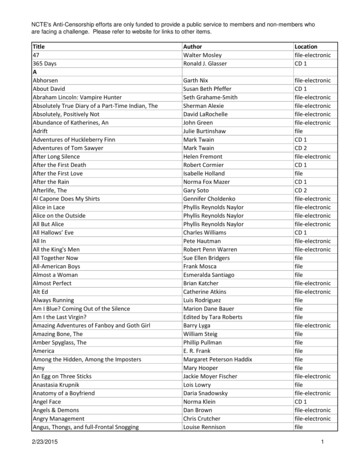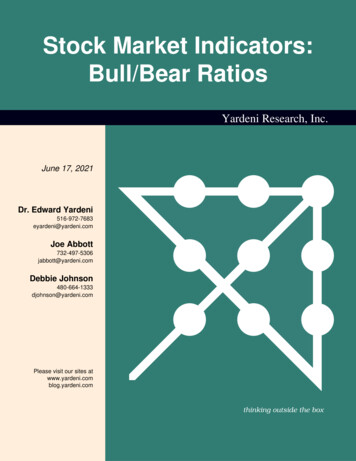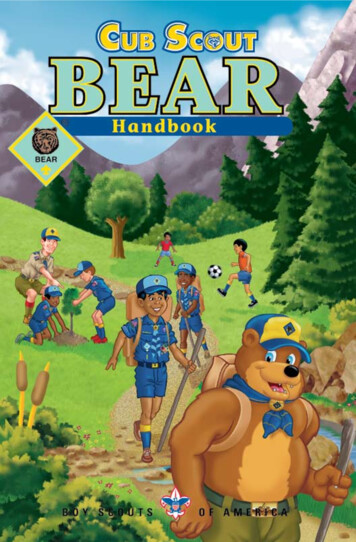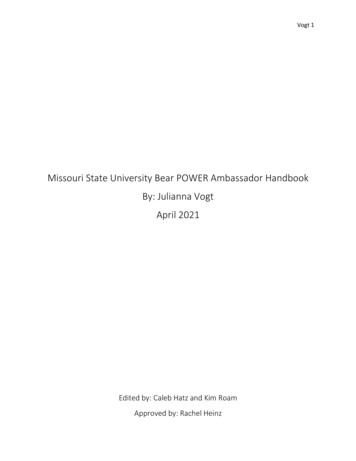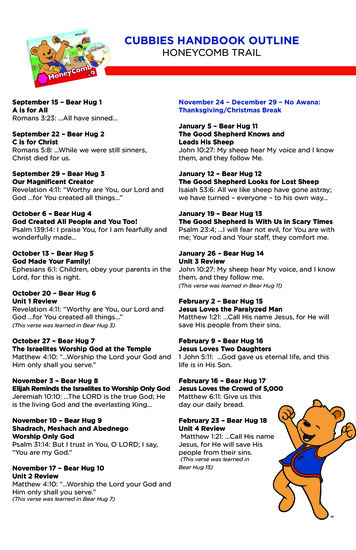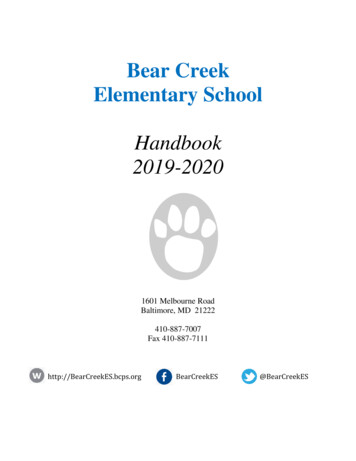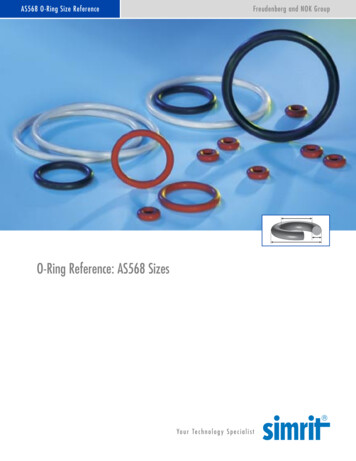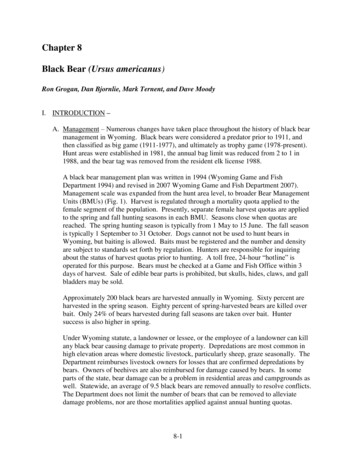
Transcription
Chapter 8Black Bear (Ursus americanus)Ron Grogan, Dan Bjornlie, Mark Ternent, and Dave MoodyI. INTRODUCTION –A. Management – Numerous changes have taken place throughout the history of black bearmanagement in Wyoming. Black bears were considered a predator prior to 1911, andthen classified as big game (1911-1977), and ultimately as trophy game (1978-present).Hunt areas were established in 1981, the annual bag limit was reduced from 2 to 1 in1988, and the bear tag was removed from the resident elk license 1988.A black bear management plan was written in 1994 (Wyoming Game and FishDepartment 1994) and revised in 2007 Wyoming Game and Fish Department 2007).Management scale was expanded from the hunt area level, to broader Bear ManagementUnits (BMUs) (Fig. 1). Harvest is regulated through a mortality quota applied to thefemale segment of the population. Presently, separate female harvest quotas are appliedto the spring and fall hunting seasons in each BMU. Seasons close when quotas arereached. The spring hunting season is typically from 1 May to 15 June. The fall seasonis typically 1 September to 31 October. Dogs cannot not be used to hunt bears inWyoming, but baiting is allowed. Baits must be registered and the number and densityare subject to standards set forth by regulation. Hunters are responsible for inquiringabout the status of harvest quotas prior to hunting. A toll free, 24-hour “hotline” isoperated for this purpose. Bears must be checked at a Game and Fish Office within 3days of harvest. Sale of edible bear parts is prohibited, but skulls, hides, claws, and gallbladders may be sold.Approximately 200 black bears are harvested annually in Wyoming. Sixty percent areharvested in the spring season. Eighty percent of spring-harvested bears are killed overbait. Only 24% of bears harvested during fall seasons are taken over bait. Huntersuccess is also higher in spring.Under Wyoming statute, a landowner or lessee, or the employee of a landowner can killany black bear causing damage to private property. Depredations are most common inhigh elevation areas where domestic livestock, particularly sheep, graze seasonally. TheDepartment reimburses livestock owners for losses that are confirmed depredations bybears. Owners of beehives are also reimbursed for damage caused by bears. In someparts of the state, bear damage can be a problem in residential areas and campgrounds aswell. Statewide, an average of 9.5 black bears are removed annually to resolve conflicts.The Department does not limit the number of bears that can be removed to alleviatedamage problems, nor are those mortalities applied against annual hunting quotas.8-1
Fig. 1. Black bear hunt areas and Bear Management Units. Boundaries were delineatedin 1994 to correspond with known black bear distributions and population centers.II. LIFE HISTORY –Black bears inhabit forested areas of all major mountain ranges in Wyoming.Populations are presumed highest in northwestern Wyoming, where higher seasonalmoisture creates more abundant forage. The Bighorn Mountains in northern Wyomingalso contain a robust black bear population. Lower densities of black bears inhabit theSnowy, Sierra Madre, Laramie Peak, and Uinta mountain ranges of southern.Black bears vary from blond to black in Wyoming. Light brown, chocolate brown andcinnamon are common. Combinations of color phases, such as light brown body withdarker brown legs, are also present. Weights of 57 adult males captured duringDepartment research and damage operations between 1988 and 2005 ranged from 120 to440 pounds (average 248 pounds). Weights of 39 adult females captured during the sameperiod ranged from 85 to 250 pounds (average 160).Black bears can be aged, and the reproductive efforts of females assessed from cementumannular rings deposited on roots of teeth (McLaughlin et al. 1990, Coy and Garshelis8-2
1992, Harshyne et al. 1998, Costello et al. 2004). Based on samples from 384 femaleblack bears harvested in Wyoming from 1988 – 2005, the average age of firstreproduction is 5.2 (Table 1). These data indicate 70% of female black bears haveproduced a litter by their 5th summer. The average birth interval was 2.2 years (n 632).Although female black bears may have up to 5 cubs per litter in more productive habitats,typical liters in Wyoming are between 1 and 3 cubs. Mean litter size of 16 female blackbears handled in winter dens from 1995 – 2005 was 1.9 cubs. The young remain with thefemale until spring/summer of their second year when they disperse and the female willagain breed.Female black bears usually enter dens in October. Males enter dens later, and all but afew adult males are denned by late November. Adult males are first to leave dens inspring, usually in late March to early April. Females with newborn cubs are last to leave,usually in late April or early May (Beecham and Rohlman 1994, Grogan 1997, Costelloet al. 2001).Food habits of black bears vary widely depending on season and location. In the RockyMountain West, black bears emerging from dens consume new growing grasses andforbs. As temperatures rise, they follow snowmelt to higher elevations focusing on thenewly greening vegetation (Beecham and Rohlman 1994). When more nutritious mastcrops (berries and nuts) ripen in late summer and fall, black bears focus intently on thesefoods (Beecham and Rohlman 1994, Costello et al. 2001). Ants, bees, and insect larvaecomprise the majority the black bear’s diet other than vegetation (Beecham and Rohlman1994). However, during early summer, newborn ungulates such as elk calves canbecome a key food source in the West (Smith and Anderson 1996, Zager et al. 2005,Zager and Beecham 2006). Irwin and Hammond (1985) determined 83–94% of thevolume of black bear diets in the Grey’s River area of western Wyoming was vegetablematter, depending on annual and seasonal variation. The bulk of remaining animalmatter consisted of carrion in spring and insects in summer and fall.Black bear populations are very susceptible to changing environmental conditions.Significant declines in reproductive success have been documented after preferred blackbear food crops failed (Beecham and Rohlman 1994). Costello et al. (2001) alsodocumented the number of bears and proportion of females harvested by hunters werehigher in years when oak mast crops failed in New Mexico. In Wyoming, the numbers ofblack bear incidents and black bears killed during the hunting season increase during verydry years and when production of critical bear foods, especially fall mast crops, is poor.During such years, bears move greater distances in search of food, making them morevulnerable to harvest and more likely to be involved in conflicts. Sometimes, they enterareas inhabited by humans.We have few reliable estimates of bear densities in Wyoming, but based on harvestindices all populations are believed stable or increasing. The total area of suitable habitatin Wyoming is approximately 74,000 ha.8-3
III. DESCRIPTION OF TECHNIQUES –A. Census –1. Mark-Recapture –a. Rationale – Mark-recapture studies are done to estimate the actual population ofbears. Procedures involve marking a random sample of animals and resamplingto estimate the proportion of marked animals in the population. The total numberof animals originally marked is extrapolated based on the proportion of markedanimals in the sample to estimate the population size. Although mark-recaptureprocedures are widely used and generally considered the most accurate method toestimate bear populations, some problems can be encountered. Two keyassumptions are difficult to rigidly meet. These include, equal probability ofcapture, and no ingress or egress of animals in the study area (geographicclosure). In addition, mark-recapture studies tend to be costly and labor intensive,which limits their practicality to small geographic areas. Total populationestimates are geographically extrapolated from representative areas. Despitethese problems, 16 of 27 states (59%) report using some form of mark-recapturetechnique to help assess their black bear populations (Garshelis 1990).b. Application – A mark-recapture study must be designed properly to be successful.Catch rates are balanced through trap spacing (to ensure all animals have accessto traps), timing and duration of trapping (to account for seasonal movements),and trap types, sets and baits (to enhance capture of trap-wise animals). Radiotransmitters may be used to detect movements across study area boundaries. Thestudy areas should be large enough to represent a population, and its attributes(habitat, hunting pressure, harvest structure) should be representative of otherareas to which the estimate may be applied.Several mark-recapture or resight methods are currently used to estimate bearabundance. The most common approach is to capture, mark, and release bears,then recapture a random sample of bears from within the population. Trappingand handling techniques are described in Erickson (1957), Johnson and Pelton(1980), and Jonkel (1993). Ear-tags and radio-collars can serve as marks.Sampling to obtain recapture/resight data can be accomplished with trapping(Lindzey and Meslow 1977, LeCount 1982, Beecham 1980), aerial observations(Miller et.al. 1997), photographs (Mace et al. 1994, Beck 1997, Grogan andLindzey 1999), or by tallying marks in the harvest (Garshelis 1990). Methodsthat do not involve handling bears include distributing baits laced with chemicalmarkers that are detectable in scats (radio-isotopes; Eager 1977, Pelton andMarcum 1977) or bones/teeth of harvested bears (tetracycline; Garshelis 1990), ortyping (profiling) DNA from hair collected at bait sites (Paetkau and Strobeck1994, Proctor 1995, Grogan and Lindzey 1999).8-4
c. Analysis of data – Various population ecology textbooks (i.e., Begon 1979, Krebs1989) describe methods used to analyze mark-recapture data. Analytical methodshave also been devised to address unique issues, such as unequal catch rates orlack of demographic closure (see Otis et al. 1978, Pollock 1982, White et al.1982, White 1996). If radio-location data are available, the estimate can beimproved by calculating the number of marked animals present during recaptureefforts (Miller et al. 1987, Miller et al. 1997) or by weighting the markedproportion based upon the time each animal spends in the trapping area (Garshelis1992). In general, lack of demographic closure (caused by births, deaths,immigration, emigration) can be addressed with the proper analysis (i.e., JollySeber), however, populations will tend to be overestimated unless the assumptionsof equal susceptibility to capture and geographic closure are met or accounted forin the analysis.d. Disposition of data – The results of any mark-recapture study should be reportedand distributed to Regional Wildlife Coordinators and the Trophy Game Section.This information is useful for evaluating hunting season frameworks and harvestquotas.2. Bait-station Surveys –a. Rationale – Bait-station surveys can provide an index to assess local abundance ofbears. Baits are placed along predetermined routes. Bears attracted to the baitsleave signs such as claw marks on a tree, tracks in sifted dirt or sand, hair on treesor shrubs, or tooth punctures in sardine cans. Bait-station surveys are easy toconduct (i.e., bear sign is easy to identify and capture/handling of bears is notneeded) and relatively inexpensive. However, there are three potentialdrawbacks. First, bears visiting more than one bait may inflate abundanceestimates. The likelihood of this occurring is relatively high since baits aretypically placed close together (0.5 mi intervals). Second, baits are typicallydistributed along roads, therefore visitation rates may indicate use of these routesby bears rather than the number of bears living in the vicinity. If bears avoid theselected road, abundance would be underestimated, as documented by LeCount(1982). Conversely, selecting a route used as a major travel lane by bears wouldlead to an overestimate. Third, bait visitation rates can be affected by availabilityof natural foods. Visitation decreases during periods of high natural foodabundance. This effect can occur between years, or more importantly, betweensampling periods within the same year. Surveys should be scheduled to provideconsistent results.b. Application – Numerous studies describe how to conduct bait-station surveys(Carlock 1986, Fendley et al. 1989, Johnson 1989, Clark 1991). Surveys typicallyinvolve multiple routes of 50 baits each. Baits are separated by 0.5 miles andplaced on alternate sides of the road. Ideally, several routes should be establishedin each major habitat type. The area surveyed should be representative of otherareas to which the results will be extrapolated. Baits should be set out the same8-5
timeframe and for the same duration each year. Weather conditions, natural foodabundance, and plant phenology should be noted to help explain fluctuations invisitation rates. Baits are generally checked after 2 to 3 weeks, and evidence ofbear visitation is recorded. Missing baits may be replaced. Baits may or may notbe moved between consecutive surveys.c. Analysis of data – The percent of baits visited is an index of bear abundance thatcan be compared among years, provided sources of bias are recognized.Visitation rates may also be compared among areas if all other factors (i.e.,natural food abundance, age/sex structure of the population) are similar. Baitstation surveys are, for the most part, used only as supporting information and notas the primary means of assessing bear populations (Garshelis 1990). At present,Wyoming does not use bait-station surveys.d. Disposition of data – The results of bait-station surveys should be reported anddistributed to Regional Wildlife Coordinators and the Trophy Game Section. Thisinformation can be useful for evaluating hunting season frameworks and harvestquotas.3. Incidental Observations –a. Rationale – Black bears are secretive, nocturnal, and live in forested habitats.Consequently, incidental sightings are rare and thus a poor index of bearabundance. However, bear sign can corroborate presence. Some states, includingWyoming, record numbers of bear sightings reported by hunters, but these datashould be viewed cautiously. For example, persons hunting over bait may reportseveral observations of the same animal.b. Application – Department personnel should record bear sign they encounter andsubmit records for inclusion in the Wildlife Observation System (WOS). Thenumber of bears observed by successful hunters should be recorded on the BlackBear Mortality Form when harvested bears are checked.c. Analysis of data – Records of incidental observations can be consulted tocorroborate other trend indicators, but should not constitute a primary measure ofabundance. Incidental observations can be tallied for each hunt area or BMU.Data can be graphically displayed by Geographic Information System (GIS)software. Observations may also be useful for reviewing environmental effects ofproposed projects, particularly if the presence of bears must be documented.d. Disposition of data – Wildlife Observation records should be forwarded monthlyto regional Wildlife Coordinators. Biological Services performs data searchesupon request. The system has recently been reprogrammed enabling fieldpersonnel to search and sort records from remote personal computer stations.Black Bear Mortality Forms should be forwarded to Regional WildlifeCoordinators, and then to the Trophy Game Section where they are entered into a8-6
statewide Black Bear database. Bear sightings by hunters are not tallied in theAnnual Black Bear Mortality Summary, but they can be requested from theTrophy Game Section if needed.B. Harvest Data –1. Harvest Survey –a. Rationale – A harvest survey is mailed annually to each licensed black bearhunter in Wyoming. The survey is designed to measure hunter effort and success.The total harvest is not estimated because it can be more accurately determinedfrom mandatory inspection data. In Wyoming, hunter surveys are done by acontracted service, and results are published in the Department’s Annual Reportand the Report of Big Game Harvest. The harvest survey is discussed inAppendix III.2. Bait Registrationa. Rationale – In Wyoming, the density of bear baits cannot exceed 1 per section offederal land. Hunters are required to register locations of baits prior to placingthem in the field. This prevents crowding of baits (and hunters), improves huntersatisfaction, and enables the Department to evaluate baiting.b. Application – Each regional office maintains a database of bait registrationrecords. As hunters register bait locations, the information is entered in thedatabase and plotted on a map. Office managers typically do this. Copies of theregional databases are forwarded to the Trophy Game Section at the end of eachhunting season (i.e., each spring and fall), and the information is compiled into astatewide database.c. Analysis of data – Bait locations can be tallied several ways. For example, baitdensities (i.e., baits/mi2) can be calculated within a drainages or hunt area.Success of hunters using baits can also be contrasted against success of hunterswho do not.d. Disposition of data – Copies of regional bait registration databases should beforwarded to the Trophy Game Section at the end of each spring and fall huntingseason.3. Sex/Age Determination –a. Rationale – Many states, including Wyoming, use sex and age composition ofharvested bears as a primary tool to evaluate and recommend management actions(Garshelis, 1990). In Wyoming, the desired harvest of female bears for a stablepopulation is 30 – 40% of the total harvest in each BMU. Further information8-7
regarding sex and age criteria is provided in the Wyoming Black BearManagement Plan (Wyoming Game & Fish Department 2007).b. Application – The skull and pelt from each harvested bear must be presented to aDepartment employee for inspection within 3 days after harvest. Harvested bearsare the only source of data presently used to monitor black bear populations inWyoming. The mandatory reporting system has been in place since 1975. Twoteeth are extracted from each bear skull and used for aging. Departmentpersonnel also record location of kill, sex, number of days hunted, and method oftake. Skulls must be presented in an unfrozen condition to allow successfulremoval of teeth. Teeth are sent to the Veterinary Lab at the University ofWyoming. Aging is based on the cementum annuli technique (Willey 1974,Stoneberg and Jonkel 1966). Proof of sex must remain naturally attached to thepelt for accurate identification. A survey conducted in 1992 indicated 96% oflicensed bear hunters comply with these regulations (University of Wyoming,1992).Game and Fish personnel identify the sex of each bear by examining genitalia.Teats of female bears are inspected to determine if the bear has previouslylactated. If a bear has not previously lactated, its teats are pinkish in color andlack pigmentation. A bear that has lactated will have darker, pigmented teats.Teats are generally swollen and milk is present if the bear is currently lactating.Although age is most accurately determined based on the cementum annulitechnique, each bear’s age is also estimated at the time it is checked. Tootheruption and wear patterns are examined for this purpose. Juveniles can usuallybe identified by body size. Estimating age in this manner is very subjective andtooth wear patterns vary depending on diet. Consequently, bear ages are assignedto the following, broader categories: Juvenile ( 1), subadult (2-4), adult (5 andover). Juvenile teeth show little wear and no staining. Cubs-of-the-year havemilk teeth and usually weigh 40 lbs. Yearlings retain some milk teeth, howeverpermanent incisors and canines have erupted, yearlings usually weigh 80 lbs.Body weights can be highly variable and should only be considered along withother factors when estimating age. Bears acquire a full set of permanent teeth byage 2. Subadult bears (2-4 yrs) typically have little to no tooth wear and somestaining. Canines are usually sharp and incisors are slightly worn. Adult bearsbetween 5 and 10 years of age generally have considerable wear on incisors,canines are rounded with slight wear patterns where lower and upper caninescontact, and staining is prominent. Bears 10 years old almost always haveconsiderable wear on incisors, and as age progresses, incisors become worn evenwith gum line. Canines are usually very rounded, chipped or broken, and wearpatterns are pronounced where upper and lower canines contact. Staining isextensive, and older bears have commonly lost one or more abscessed molars.c. Analysis of data – Sex and age data are used to evaluate harvest in each BMU.Desired harvest composition is 30 – 40% females. Adult females should8-8
comprise 45 – 55% of the female harvest (Wyoming Game & Fish Department2007).d. Disposition of data – Tooth samples and copies of Black Bear Mortality forms aresent to Regional Wildlife Coordinators. Coordinators forward these to the TrophyGame Section. The information from each form is entered into a statewidedatabase. Tooth samples are sent to the Game and Fish Laboratory for agedetermination. Harvest composition (sex and age) is reported in the Annual BlackBear Mortality Summary prepared by the Trophy Game Section.4. Body Condition –a. Rationale – Body condition is an indication of health and fitness, and can beuseful in assessing habitat quality and general condition of the population (Bailey1984, Smith 1990). The Department does not use a quantitative method toevaluate body condition. The condition of each harvested bear is qualitativelyassessed when it is inspected through the mandatory check process. Theconditions of all captured bears are also noted.b. Application – Presence and quantity of fat are the basis for assessing excellent,good, fair, or poor condition when each bear is checked or captured. Thecondition is recorded on each mortality form or capture form.c. Analysis of data – The Department does not currently analyze body conditiondata. However, biologists may refer to this data when evaluating environmentalconditions or population status in specific areas.d. Disposition of data – Information about body condition is recorded on Black BearMortality and Capture forms. Copies of the forms are sent to Regional WildlifeCoordinators. After proofing, Coordinators forward them to the Trophy GameSection. The information from each form is entered in a statewide database.5. Laboratory Aging by Tooth Cross-Sectioning –a. Rationale – The most reliable method of aging bears is based on counting annularlayers of cementum in tooth cross-sections (Marks and Erickson 1966, Stonebergand Jonkel 1966, Willey 1974, Kolensky and Strathearn 1987). A layer ofcementum is deposited each year around the dental roots of mammals. Theselayers indicate age in years (Dimmick and Pelton 1994). Older bears can bedifficult to accurately age because outer annuli are deposited in thinner layers(Willey 1974). False and double annuli are also present in some bears (Morris etal. 1978). However, estimates derived from tooth annuli provide the mostaccurate age information for managing bear populations.b. Application – The cementum annuli technique involves both field and laboratoryprocedures. A tooth must first be extracted from captured or harvested bears. To8-9
ensure consistency, we recommend using the first premolar (pm1) to age blackbears (Dimmick and Pelton 1994). This tooth is located directly behind the upperor lower canine.Teeth can be removed with various dental elevators or tooth extraction devicesavailable through veterinary supply companies. Waddell (1975) describes thetechnique and tools used to remove black bear teeth. Exercise care to maintainthe integrity of the tooth. In most cases, it is imperative to keep the root of thecollected tooth intact (Dimmick and Pelton 1994). If the root is broken, removeanother tooth (there are generally 4 vestigial premolars). In addition, you shouldtake into consideration the well being of live animals and preservation of trophyskulls. However, these teeth are very small, sometimes barely breaking the gumline. Removing more than one should not impair the appearance of trophy skulls,nor should it affect the function of live bears. After teeth are removed, theyshould be kept clean and placed in a small, properly labeled envelope.Reproductive histories of female black bears can also be reconstructed fromcementum annuli (Coy and Garshelis 1992). It is possible to obtain suchinformation as age at first reproduction, interval between reproductive efforts, andnumber of reproductive efforts. These reproductive histories can help biologistsestimate reproductive rates, construct population age structures, and set harvestquotas.c. Analysis of data – The Game and Fish Laboratory determines ages andreproductive histories. The lab returns this data to the Trophy Game Sectionwhere it is assessed based on criteria in the Wyoming Black Bear ManagementPlan (Wyoming Game & Fish Department 2007).d. Disposition of data – Bear teeth and accompanying data forms are sent toRegional Wildlife Coordinators. After proofing forms, Coordinators forwardthese to the Trophy Game Section where they are cataloged and forwarded to thelab. Data are summarized in an annual report of black bear mortality. Thesereports are available through the Trophy Game Section.C. Capture and Handling –1. Trapping and Marking –a. Rationale – Bears are captured and marked for various reasons including researchto estimate sex and age structure of a population, population size and density,home ranges, and habitat use patterns (Lindzey and Meslow 1977, Beecham 1983,Garshelis 1992, Beck 1997, and Grogan 1997). Trapping may also be necessaryto manage nuisance bears (Wyoming Game & Fish Dept. 1994). Personnelshould be thoroughly familiar with capture and handling techniques to assuresafety and proper care of the bear.8-10
b. Application – Several effective techniques are available to trap bears. TheDepartment generally uses trailer-mounted culvert traps or foot snares, dependingon accessibility of the site and public safety concerns. Culvert traps are used nearareas of concentrated human activity such as housing developments orcampgrounds. Foot snares are used when many traps are needed during researchefforts, or when accessibility by motorized vehicle is limited. Trappingtechniques are discussed by Jonkel (1993). Baits such as commercial scent lures,animal parts or other food items are used to attract bears into trap sites.Once captured, bears are immobilized with Telazol (a combination of tiletiminehydrochloride (HCL) and zolazepam HCL). Dosage is 7 mg/kg (Kreeger 1996).Bears can tolerate imprecise dosages of Telazol. It is rapid acting and allows agradual recovery in bears (Gibeau and Paquet 1991). Telazol is generallydelivered by a CO2-powered pistol, dart rifle, or jab stick. Bears 1 year of ageare sometimes fitted with a radio transmitter collar. Cotton spacers are used in thecollars to increase the likelihood the collar will be shed after 2-3 years ( Jonkel1993).Each bear is fitted with ear-tags and marked with an identification tattoo whenpossible. Round, hog-button style ear tags are used. Each tag has a uniquenumber on one side and the letters WGFD on the other signifying the bear wascaptured by the Wyoming Game & Fish Department. Tattoo pliers are used toplace a tattoo on the inside upper lip. The tattooed number generally correspondswith the ear tag number.Several morphometric measurements are recorded during capture, includingweight, total length, contour length, girth, height, neck circumference, head lengthand width, and pad length and width. Mammary nipple length, width andpigmentation, and vulva condition are recorded to assess reproductive status offemales (Jonkel and Cowen 1971, LeCount 1986, Beck 1991). Depending on thepurpose of trapping, bears are either released on site or relocated.c. Analysis of data – The Department does not formally analyze bear capture data.However, the Trophy Game Section maintains a statewide database of captureinformation, and data are available upon request.d. Disposition of data – Any time a bear is anesthetized, a Large Predator CaptureForm must be completed. When bears are not anesthetized (only trapped andmoved), the sections of the capture form pertaining to date and location ofcapture, date and location of release, and a physical description of the bear mustbe completed. Capture forms are sent to Regional Wildlife Coordinators. AfterCoordinators have proofed the forms, they are forwarded to the Trophy GameSection and the information is entered in a statewide database.8-11
2. Relocation –a. Rationale – Relocation of offending animals is often necessary to resolve conflictsbetween bears and humans. In each case, the decision to move a bear is made byregional enforcement personnel. Bears are usually moved to prevent furtherconflicts such as garbage raiding, livestock depredations, or property damage.Relocation gives the bear an opportunity to stay out of trouble. Once relocated,young bears often remain in the general vicinity of the release site, however olderbears frequently return to the location where the conflict happened, especiallywhen a food reward has been obtained. In most cases, the preferred managementaction is to move a nuisance bear at least once before lethal measures areconsidered.b. Application – The safest way to transport bears is in a culvert-type trap mountedon a trailer. Bears should be fully conscious when being transported. If the bearhas been anesthetized, it should be allowed to recover before transportingcommences. Keep the trap/trailer out of direct sunlight when it is parked. If thebear will be move
1988, and the bear tag was removed from the resident elk license 1988. A black bear management plan was written in 1994 (Wyoming Game and Fish Department 1994) and revised in 2007 Wyoming Game and Fish Department 2007). Management scale was expanded from the hunt area level, to broade


